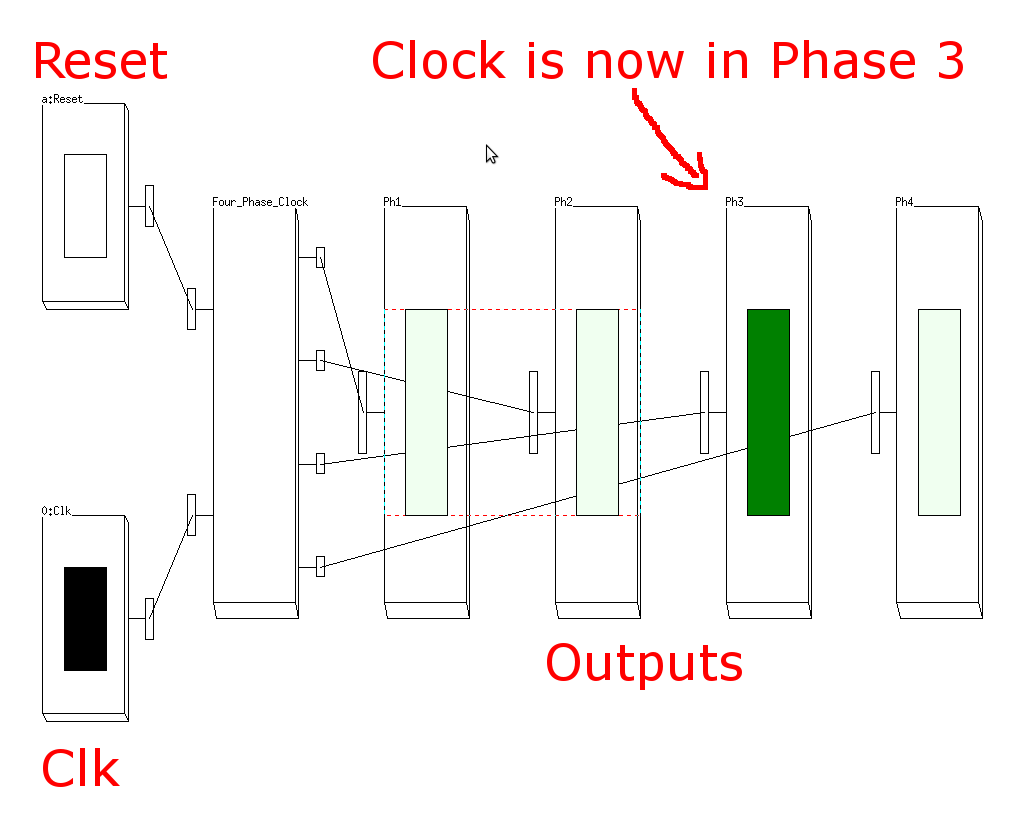Background: the CPU's job is to execute an instruction. In order to execute an instruction correctly, a number of events must happen in a specific chronological order. The events are always "change the value of some (special/general purpose) registera". Since registers are updated with a clock signal, the chronological ordering of the (register ipdate) events can be control using a series of clock signals that where each clock signal is "displaced" (see figure below). In the first part of the assignment we will use a 4 state FSM (finate state machine) and a decoder to create a 4 phase clock.
Description of the input and output signals of the 4 phase clock circuit:
- The 4-phase clock
circuit component (= macro)
has 2 inputs and 4 outputs:
- The inputs are:
- Reset: used to reset the 4 phase clock to phase 1
- Clk: signal used to make the 4 phase clock move to the next phase
- The outputs of
the 4 phase clock are:
- Ph1: phase 1 signal of the 4 phase clock
- Ph2: phase 2 signal of the 4 phase clock
- Ph3: phase 3 signal of the 4 phase clock
- Ph4: phase 4 signal of the 4 phase clock
- The inputs are:
|
|
The macro header of the 4 phase clock is as follows (given in the prepared file):
Define Four_Phase_Clock Reset Clk | Ph1 Ph2 Ph3 Ph4; /* Write the 4-phase clock circuit here */ Endef; |
The Four_Phase_Clock cuicuit will be implemented using a FSM (Finite State Machine)
The meaning of inputs are as follows:
- Reset:
- When Reset = ONE, it will
reset the FSM in
4-phase clock to the
state 00
which corresponds to the
phase 1
of the 4 phase clock
- When Reset = ZERO, the
FSM in the
4-phase clock will
transit to
the next state
each time you turn the
Clk signal
OFF and then ON
The state transition diagram is given below.
- When Reset = ONE, it will
reset the FSM in
4-phase clock to the
state 00
which corresponds to the
phase 1
of the 4 phase clock
- Clk = used to make the FSM in the 4-phase clock move to the next state (will only work when Reset = ZERO)
|
|
In addition to making the FSM, you need to use the state of the FSM to control 4 output signals. The output signals of the 4 phase clock are controlled by the state of the FSM as follows:
- Ph1: equals to 1 if the FSM in the 4 phase clock is in state 00, otherwise equals to 0
- Ph2: equals to 1 if the FSM in the 4 phase clock is in state 01, otherwise equals to 0
- Ph3: equals to 1 if the FSM in the 4 phase clock is in state 10, otherwise equals to 0
- Ph4: equals to 1 if the FSM in the 4 phase clock is in state 11, otherwise equals to 0
|
|
How to make the 4-phase clock component
- A switch
(the Reset input signal
connected to key 1)
used to reset the FSM:
- When the Reset signal is equal to ONE, it forces both Dffs of the 4-phase clock to ZERO.
- When the Reset signal is equal to ZERO, the Dffs will operate as ordinary Dffs (see: click here)
- A switch (the Clk input signal connected to key 0) that functions as the manual clock that advances the state of the FSM.
- Ph1 will only be 1 if and only if the Finite State Machine is in state 00
- Ph2 will only be 1 if and only if the Finite State Machine is in state 01
- Ph3 will only be 1 if and only if the Finite State Machine is in state 10
- Ph4 will only be 1 if and only if the Finite State Machine is in state 11
To implement the 4-phase clock, you will first implement a 4-states Finite State Machine with the following state transitions:
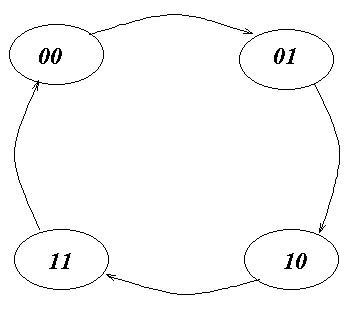
|
The Finite State Machine will have no input signal !!! (That means the transitions of FSM will always be the same - in our case, it goes in circles...).
The circuit does have 2 input switches that perform the following functions on the D-flipflops of the FSM:
|
|
You must first implement the Finite State Machine (FSM) given in the above figure.
After you finish the FSM, add additional combinatorial circuit (figure out what you need yourself) to translate the state of the FSM to the 4 outputs Ph1, Ph2, Ph3 and Ph4 of the clock:
|
|
If we plot the outputs of the 4 signals of the 4-phase clock over time, it will looks as follows: (time flows from left to right in the figure below, so the signal further to the right is "later" in time)
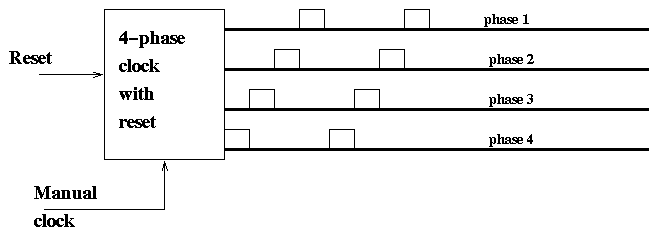
|
The state change of the 4-phase clock is controlled by the manual clock input signal (associated to key 0)
Testing the 4-phase clock component
-
After you have written the
CLK macro
in the file
clock.h,
you can test the CLK circuit
using this command:
- Press a to
reset the
4-phase clock
(Press a again to allow the 4-phase clock to run)
- Press 0 to run the 4-phase clock
/home/cs355001/bin/cs355sim help-CLK |
The test circuit (help-CLK) that you see will look as follows:
|
You can interact with the help-ALU test circuit as follows:
|
Details on how to test the 4-phase-clock macro is given next.
How to verify the correctness of your CLK circuit: (what is the correct behavior)
- When the simulation starts,
you will see the following
state:
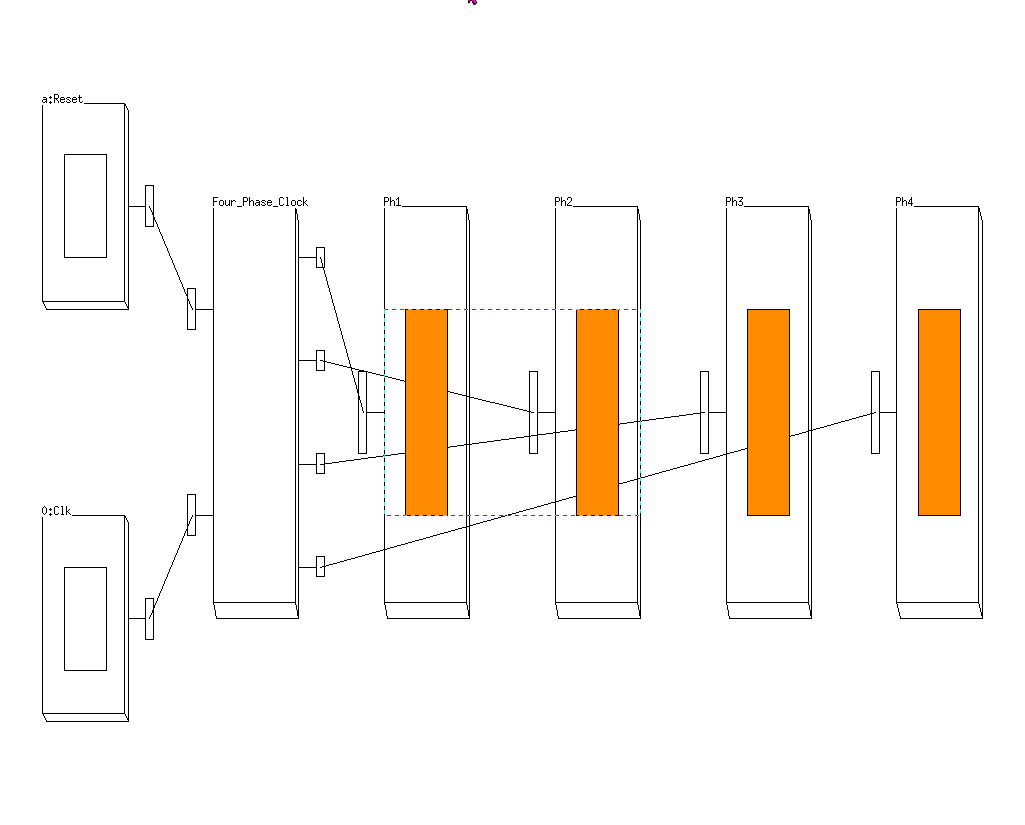
- Press a: you will see the clock
go to phase 1
immediately:
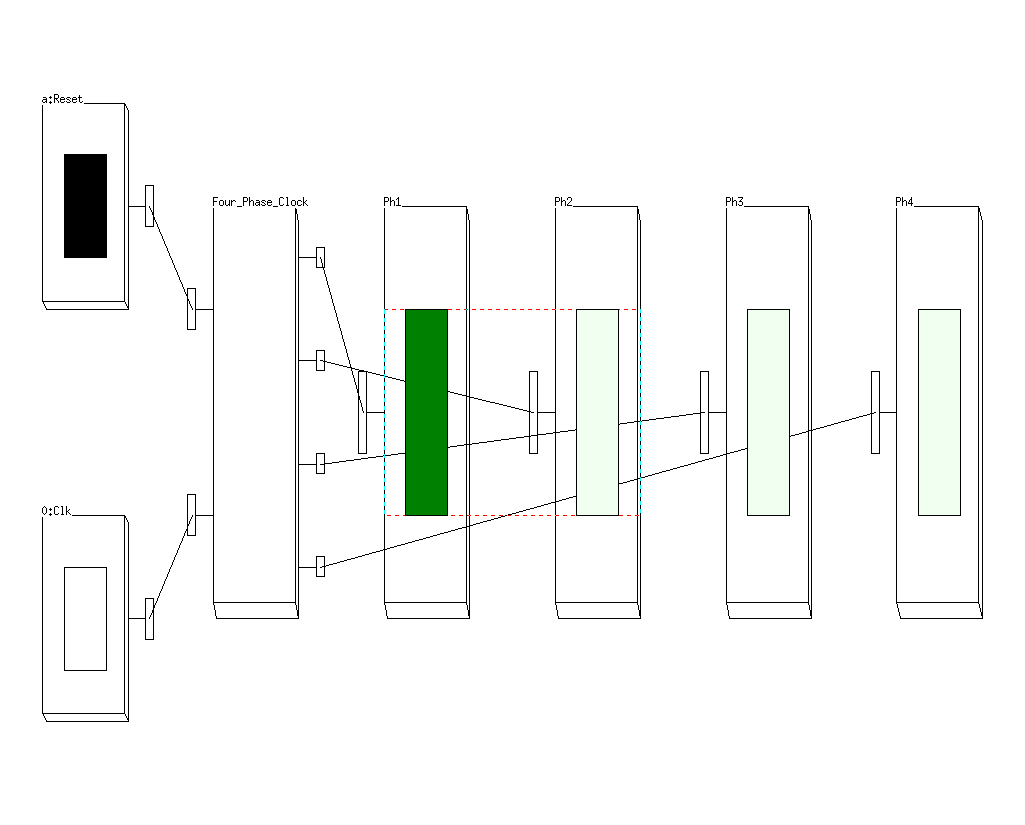
- Press a again
--- you need to release the
reset:
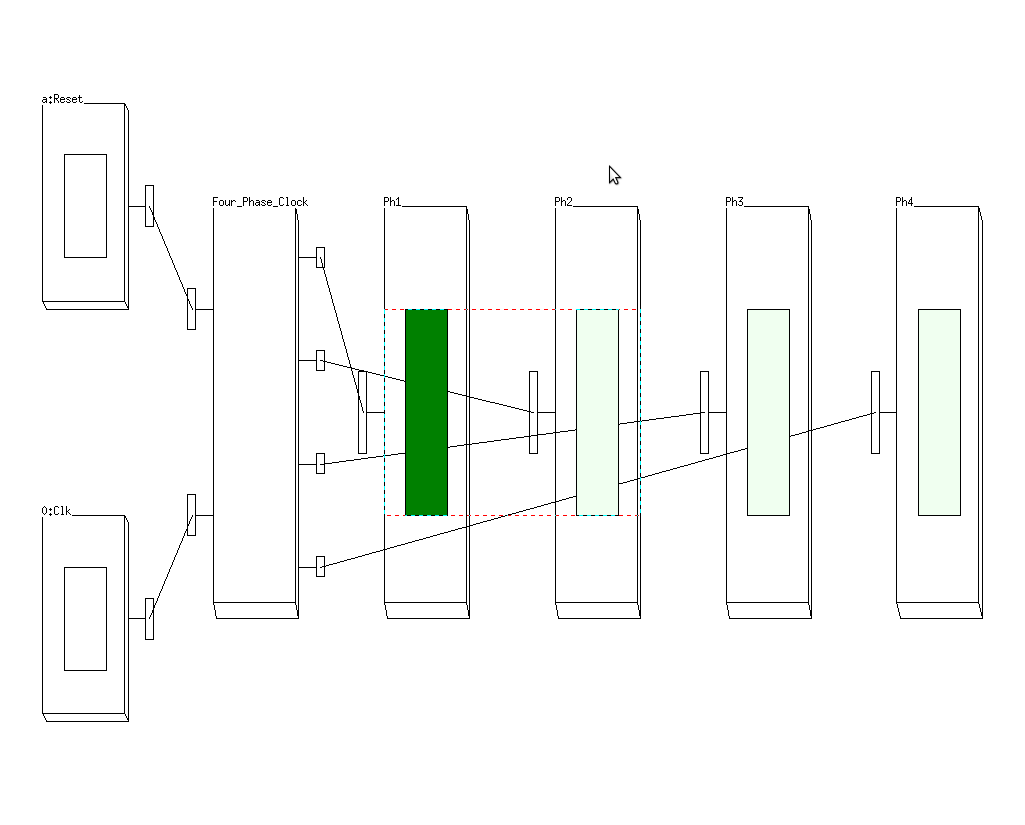
The clock circuit can now run.
- If you press 0
repeatedly and
you will see:
- For every 2 presses, the
4 phase clock will
advance 1 phase.
- You will see the light move to the right and then wrap around at the end (i.e.: first light will light up after it wraps around)
You can observe the correct behavior by running this program and use the above instructions to interact with the circuit:
/home/cs355001/Solutions/hw4-CLK
- For every 2 presses, the
4 phase clock will
advance 1 phase.
|
|
-
Background information: in CS255, we learned that the
CPU can perform 2 kinds of program flows: in order
(next instruction follows current instruction) and out of order
(next instruction is store elsewhere).
The PC_with_Branching
circuit
will show you how these 2 kinds of program flows
are implemented in hardware.
When the Branch is
ZERO, the CPU will perform
in order program flow (PC is incremented by 1) and
otherwise, the CPU will
branch to an (input) address given by
PC[7..0]
- Reset:
- When Reset = ONE, it will reset the
Program Counter to
00000000
- When Reset = ZERO, the
PC component will be
updated to
the next PC value
each time you toggle the
Clk signal
OFF and then ON
The PC value is equal to PC+1 when Branch=0
The PC value is equal to the Addr input when Branch=1
- When Reset = ONE, it will reset the
Program Counter to
00000000
- Clk =
make the Program Counter take on the
next program address value
- The next program address value of the PC depends on the branch signal !!!
- Branch:
the branch indication signal
Effect:
- If Branch = 0, then the next program address value taken on by the PC is equal to current PC value + 1
- If Branch = 1, then the next program address value taken on by the PC is equal to the Address input value Addr[7..0]
- Addr[7..0] = the
8 bits
branch address
- The PC_with_Branching circuit will taken on the value Addr[7..0] when Branch = 1 (and you give a Clk signal to the PC_with_Branching circuit)
- PC[7..0] = 8 bits value representing the address stored in the PC component
The macro header is as follows:
Define PC_with_Branching Reset Clk Branch Addr[7..0] | PC[7..0]; /* Write your PC_with_Branching component here */ Endef; |
The inputs of the PC_with_Branching component are as follows:
|
|
The output signals of the PC_with_Branching component are as follows:
|
|
How to make the PC_with_Branching circuit
-
The PC_with_Branching circuit was
not discussed in class (will be discussed later) and
but I will show you how to make it.
- Reset:
is used to reset the
8 Dffs of the
PC to the
value 0
- Branch:
controls a multiplexor to
select the input of the
8 Dffs used to store
the value of the
PC
If Branch=0, the multiplexor will select the PC+1 input.
If Branch=1, the multiplexor will select the (Branch) Address input.
Important note: use the EDiSim built-in multiplexor ! (because just one built-in multiplexor can multiplex all the 8 bits in the PC !!!)
- Clk: is the
clock signal of the
8 Dffs used to store
the value of the
PC
Schematically, the PC_with_Branching circuit looks like this:

|
The input parameters of the PC_with_Branching component have the following functions:
|
|
Testing the PC_with_Branching circuit
-
After you have written the
PC_with_Branching macro
in the file
clock.h,
you can test the PC_with_Branching circuit
using this command:
- Press a to
reset the
PC component
- Use key 1 to
select
branch/no branch:
- Branch signal = 0 means:
don't branch
(i.e.: continue to next instruction)
Then PC will increase its address after each clock signal
- Branch signal = 1 means:
branch to the
given address
Then PC value will change the address value after a clock signal
- Branch signal = 0 means:
don't branch
(i.e.: continue to next instruction)
- Use the keys
2, 3, 4, 5, 6, 7, 8, 9
to set the 8 bit (branch) address
- Key 0 is the clock signal for the PC component
/home/cs355001/bin/cs355sim help-PC |
The test circuit (help-PC) will look as follows:
|
You can interact with the help-ALU test circuit as follows:
|
- When you run
/home/cs355001/bin/cs355sim help-PC,
you will see this
initial state:

- Press a (= Reset) and
you will see the output
PC[7-0]
go to 00000000
immediately

- Press a again
--- to release the
reset so that the
PC circuit run
normally.
- While switch '1' (Branch) = 0, when
you press 0 repeatedly,
you will see that:
- For every 2 presses, the
PC circuit will
increase by
1.
(I.e.: if you don't branch, the next instruction is found in the memory location that follows the current memory address)
This simulate the fact that the CPU will fetch the next instruction located at the next memory address
- For every 2 presses, the
PC circuit will
increase by
1.
- To make the PC
branch to
a memory address:
- Set the
branch address using the
key 2, 3, 4, 5, 6, 7, 8, 9
- Press 1 to
set Branch = 1
- Then press 0 twice
- The PC output will be equal to the branch address
You can observe the correct behavior by running this program and use the above instructions to interact with the circuit:
/home/cs355001/Solutions/hw4-PC
- Set the
branch address using the
key 2, 3, 4, 5, 6, 7, 8, 9
|
|
